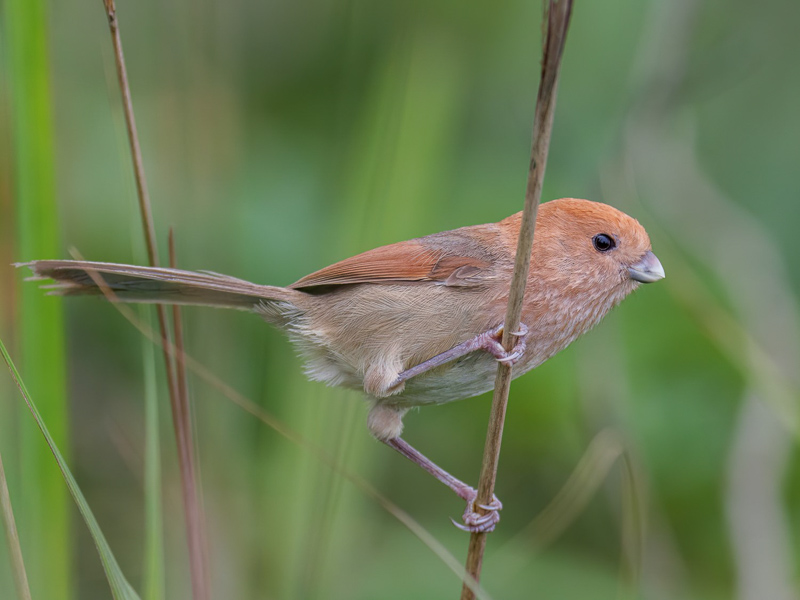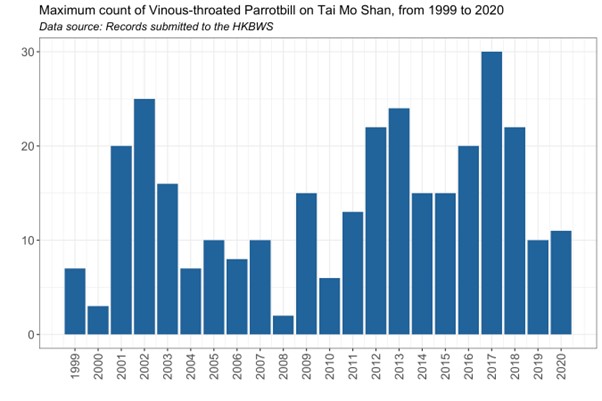Vinous-throated Parrotbill Suthora webbiana 棕頭鴉雀
Category IIA. A small, but apparently stable, population considered to be derived from ex-captive birds is established on Tai Mo Shan.
IDENTIFICATION

May 2023, Robert Hackel.
11-13 cm. A small, long-tailed bird similar in size to a prinia but plumper-bodied and larger-headed with a short stubby bill. Plumage largely brownish-pink, orange on the head and paler below; flight feathers rufous and remainder of upperparts including tail mid-brown. Round head and absence of any eye-stripe or supercilium gives Vinous-throated Parrotbill a beady-eyed appearance.
VOCALISATIONS
Chattering notes are uttered as contact calls and when agitated or alarmed.
Advertising calls are moderately high-pitched modulated notes sometimes introduced by a chatter.
DISTRIBUTION & HABITAT PREFERENCE
Vinous-throated Parrotbill is restricted to shrubby grassland and, especially, dwarf bamboo at or above about 600m altitude on Tai Mo Shan.
OCCURRENCE
Vinous-throated Parrotbill was first recorded in HK in 1971 when two were seen at Po Shan, but this and five subsequent records up to 1980 were judged to be ex-captive birds (Carey et al. 2001). It was first recorded at Tai Mo Shan in 1980, when a nesting pair was observed and up to 12 were seen in most subsequent years up to 1998. It has been reported annually since 1999 (Figure 1) in fluctuating numbers with no clear population trend; the peak count of 30 birds was obtained on 8 November 2017.
Carey et al. (2001) detailed a number of records from other widespread locations, including urban sites and concluded that most or all of these referred to ex-captive birds, further noting that there was no indication that Vinous-throated Parrotbill was becoming established elsewhere. This remains the case, with the only other 1999 – 2020 records being a party of seven at Ng Tung Chai on 9 August 2017 and two between Ng Tung Chai and Leadmine Pass on 16 February 2018 and 20 June 2020. These could relate to dispersing birds from Tai Mo Shan at about their lower elevational limit, which Lewthwaite (1996) considered to be 600m in Guangdong. There is no other evidence of altitudinal or other movements in HK.
Carey et al. (2001) discussed in detail the reasons for considering the HK population related to ex-captive birds; in short, Vinous-throated Parrotbill is non-migratory and is confined to elevations above 600m in Guangdong, it is frequently recorded in the cagebird trade and, unlike some other species that have colonised HK in recent years, there is no evidence that natural wild populations have become established in southern Guangdong in recent years.
BREEDING
There is limited information from HK: nest building (carrying a dwarf bamboo leaf) has been observed on 23 March, feeding of juveniles on 26 May and 7 June and fledged young on 1 July.
BEHAVIOUR, FORAGING & DIET
Vinous-throated Parrotbill is typically recorded in pairs, family parties or in flocks moving through dwarf bamboo, tall grass or grassy shrubland. Flocks are often noisy and confiding and individuals regularly perch on top of bamboo stems or on shrubs. Diet is unrecorded in HK other than an observation of one of the 1980 breeding pair carrying a ‘grub’ presumably as food for young.
RANGE & SYSTEMATICS
Found throughout southern and eastern China except Hainan (Liu and Chen 2021), its range extends into southeast Russia, Korea and north Vietnam. There are six races: S. w. mantchurica is found in northeast China and southeast Russia, S. w. fulvicauda occurs in Hebei and Korea, S. w. suffusa is found in central China south to north Vietnam, S. w. webbiana is found in Jiangsu and Zhejiang, S. w. elisabethae is found in southeast China, whilst S. w. bulomacha is restricted to Taiwan. It is not known which race occurs in HK but Carey et al. (2001) considered that birds at Tai Mo Shan matched the appearance of webbiana.
CONSERVATION STATUS
IUCN: Least Concern. Population trend stable.
Figure 1.

Carey, G. J., M. L. Chalmers, D. A. Diskin, P. R. Kennerley, P. J. Leader, M. R. Leven, R. W. Lewthwaite, D. S. Melville, M. Turnbull & L. Young (2001). The Avifauna of Hong Kong. Hong Kong Bird Watching Society, Hong Kong.
Cheng, T. H. (1987). A Synopsis of the Avifauna of China. Science Press, Beijing.
Lewthwaite, R. W. (1996). Forest birds of Southeast China. Hong Kong Bird Report 1995: 150-203.
Liu, Y. and S. H. Chen (2021). The CNG Field Guide to the Birds of China (in Chinese). Hunan Science and Technology Publication House, Changsha.

